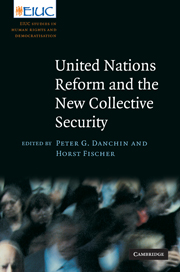Book contents
- Frontmatter
- Contents
- List of contributors
- Series editors' preface
- Preface
- List of abbreviations
- Introduction: the new collective security
- PART I Law and politics in United Nations reform
- PART II Defining “threats” to collective security
- PART III Prevention and responses
- 7 On the far side of conflict: the UN Peacebuilding Commission as optical illusion
- 8 The new peacebuilding architecture: an institutional innovation of the United Nations
- 9 The World Summit process and UN sanctions reform: between rhetoric and force
- 10 The UN response to the evolving threat of global terrorism: institutional reform, rivalry, or renewal?
- 11 International justice and collective security: between pragmatism and principle
- PART IV Perspectives on the ground
- Bibliography
- Index
10 - The UN response to the evolving threat of global terrorism: institutional reform, rivalry, or renewal?
from PART III - Prevention and responses
Published online by Cambridge University Press: 05 May 2010
- Frontmatter
- Contents
- List of contributors
- Series editors' preface
- Preface
- List of abbreviations
- Introduction: the new collective security
- PART I Law and politics in United Nations reform
- PART II Defining “threats” to collective security
- PART III Prevention and responses
- 7 On the far side of conflict: the UN Peacebuilding Commission as optical illusion
- 8 The new peacebuilding architecture: an institutional innovation of the United Nations
- 9 The World Summit process and UN sanctions reform: between rhetoric and force
- 10 The UN response to the evolving threat of global terrorism: institutional reform, rivalry, or renewal?
- 11 International justice and collective security: between pragmatism and principle
- PART IV Perspectives on the ground
- Bibliography
- Index
Summary
Introduction
The use of terrorism as a tactic is not new, having been used for centuries by both states and non-state actors to further political ends. What is new, however, is the dramatic increase in the number of terrorist attacks around the globe by stateless international terrorist groups, including Islamist terrorist groups such as Al-Qaeda and like-minded groups. While it may be tempting to explain away this increase by attributing it to partisan attacks in Afghanistan and Iraq, research has shown the phenomenon is truly global. There has been a 35 percent increase in the number of reported Islamist terrorist attacks outside those two countries with a 12 percent rise in fatalities related to those attacks. With this upsurge in international terrorist violence, even the most economically and militarily powerful of countries now recognize that no single state or group of states can effectively fight this threat alone. As recognized by the Secretary-General's High-Level Panel on Threats, Challenges and Change (HLP):
In today's world, a threat to one is a threat to all. Globalization means that a major terrorist attack anywhere in the industrial world would have devastating consequences for the well-being of millions in the developing world … The erosion of State capacity anywhere in the world weakens the protection of every State against transnational threats such as terrorism … Every State requires international cooperation to make it secure.
- Type
- Chapter
- Information
- United Nations Reform and the New Collective Security , pp. 250 - 281Publisher: Cambridge University PressPrint publication year: 2010



